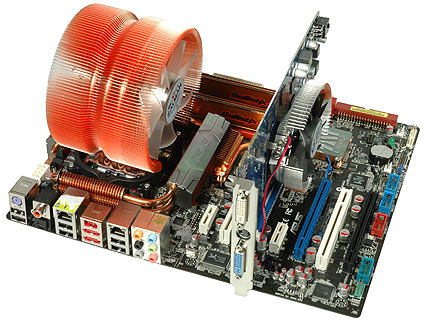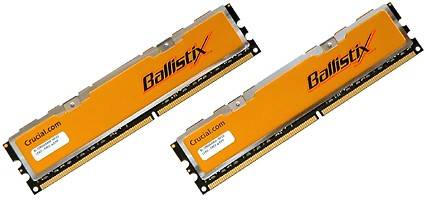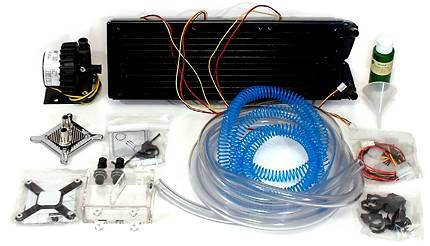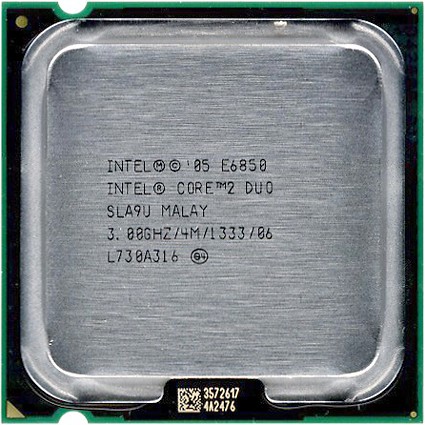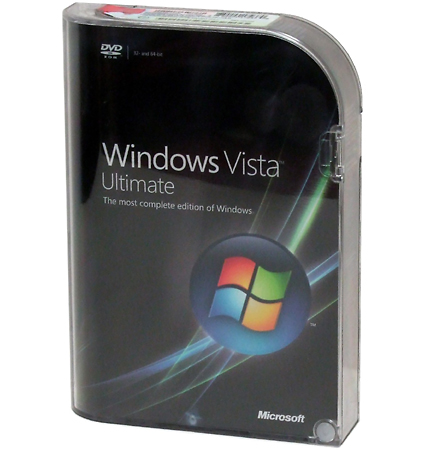X48 Motherboard Comparison
Test Settings
Hardware And Operating System
| System Hardware | |
|---|---|
| Socket 775 Processor | Intel Core 2 Duo E6850(Conroe 65 nm, 3.00 GHz, 4 MB L2 Cache) |
| DDR3 System Memory | Crucial Ballistix BL12864BA1608.8SFB DDR3-16002x 1024 MB at DDR3-1066, CL 5.0-5-5-15 |
| DDR2 System Memory | Crucial Ballistix BL12864AA804.16FD3 DDR2-8002x 1024 MB at DDR2-1066, CL 5.0-5-5-15 |
| Hard Drive (System) | Western Digital WD1500ADFD-00NLR1, Firmware: 20.07P20150 GB, 10,000 RPM, 16 MB cache, SATA/150 |
| Hard Drives (Empty) | 2x Western Digital Caviar WD7500AAKS, RAID 0750 GB, 7200 RPM, 16 MB Cache, SATA 300 |
| Graphics Card | Gigabyte GV-RX385512H (Radeon HD 3850)670 MHz GPU, 512 MB GDDR3-1660 |
| Sound Card | Asus Xonar D2X (PCI Express) |
| Power Supply | Coolermaster RS850-EMBA (850W, ATX12V v2.2) |
| System Software & Drivers | |
| OS | Windows Vista Ultimate 6.0.6000 (Vista Retail) |
| DirectX Version | DirectX 10.0 |
| Platform Drivers | Intel INF 8.6.0.1006 |
| Graphics Driver | ATI Catalyst 7.12 |
We started off with our latest reference system for comparison purposes, but made a few minor changes to better match the specific testing needs of today's review.
Since one of our test systems used DDR2 SDRAM, we had to pick a good set to match the speed and timings of the DDR3 motherboards. Our choice was rather easy, since we had a pair of Crucial Ballistix PC2-6400 capable of running up to a 1252 MHz data rate at CAS 5-5-5-15.
Comparing DDR2 and DDR3 platforms required finding memory speed and latency values that would be suitable for both memory types. We ran all benchmarks (save for the overclocking tests) at 1066 MHz data rate and CAS 5-5-5-15, using the "Automatic" timings for the remaining settings whenever available. Readers who believe that using such low data rates with DDR3 memory poses a significant performance handicap are welcome to read our DDR3 Speed and Latency Shootout for proof to the contrary.
The Zalman CNPS9700 reference cooler was useful in accessing the mounting space around each motherboard's CPU socket, but our particular testing needs favored a more elaborate system. A liquid cooling configuration would allow us to measure VRM temperature independently of the CPU cooler's cross-draft effect, and choosing a large one would let us reach the maximum "ambient temperature" overclock of our CPU.
For today's comparison, we chose Swiftech's Apogee GTX water block, MCP-655b high-flow pump and 120 mm x3 fan radiator. This same cooling system has already been used in two previous motherboard shootouts.
The reference system had also used a Core 2 Duo E6850 Engineering Sample, but we realize that the majority of readers don't have access to such parts. To better represent the results that retail buyers might achieve, we used a retail boxed processor of the same rating.
We also wanted to test the performance capabilities of each motherboard's PCI Express (third-party) RAID controller, so we brought back the super-fast Western Digital WD7500AAKS drives from a previous article.
Get Tom's Hardware's best news and in-depth reviews, straight to your inbox.
The ICH9R southbridge has its own RAID capabilities, and performs nearly identically on different motherboards. Thus, it serves as the basis for comparison when testing the third-party add-in controllers of today's X48 motherboard contenders.
We also wanted to check the sound quality of onboard devices, but needed a high-quality input device to analyze the output of each motherboard's codec. After completing our full benchmark suite using onboard audio only, we added the Xonar D2X as an audio receiver for sound quality tests. Just as the Asus P5E3 Deluxe reference board and its ICH9R RAID controller serve as the basis for comparison in performance tests, the Xonar D2X serves as both the capture device for testing onboard audio output, and as the basis for quality comparison, by capturing its own output.
The final change should have no affect on performance throughout our limited number of tests, but we need to mention it anyway. Since the Windows Vista Enterprise licenses of the major labs are not available to independent testers, today's benchmarks use Windows Vista Premium, Retail Boxed.
-
Help please.Can this board be configured with the first two (SATA) HDs mirrored and the other drives JBOD? Thank you in advance.Reply
-
oblivionspell Great review, very detailed and informative. But I must say that either you were lucky that your X38 P5E3 Deluxe came with a better-than-average chipset or that I wasn't so lucky and got a malfunctioning one.Reply
I have an Asus Maximus Formula which is, as you know, the Republic of Gamer's solution for the X38 and recently bought a Patriot Extreme Performance 1150mhz PC2-9600. Whenever I try anything above 1020mhz for the RAM my PC reboots; the higher it is the less time it takes to do it. At 1020mhz it'll only reboot if I run something more demanding like 3dMark06 or any new game, at 1100mhz it'll barely show the Windows loading screen then reboot, above 1120mhz it'll not even load windows and freeze. But in every case it boots up fine.
The Asus forums are full of users who can't get stability in any way with >=1066mhz ram on X38 boards. A selected few have come to accomplish it however, which leads me to think those were the lucky ones who got the good shipment, like you. The Patriot forums are the same, X38 users can't get their system stable with RAMS over 1066 or not even that.
Maybe that X48 "official" support is something to consider, it might be the fix to the X38 we users are looking for. Even if it's only to make sure it'll run RAMs at >=1066mhz, it's good enough already.
-
oblivionspell - Have you tried manually setting your RAM voltage to the correct value for the performance setting(s)?Reply
I had to do this on my Asus Crosshair, even though EPP is supposed to take care of it for you. Without manually setting the voltage, I had memory corruption and crashes, but could use the non-EPP mode. With the voltage bumped to the correct 2.1V,
the EPP modes work perfectly. -
Crashman oblivionspellGreat review, very detailed and informative. But I must say that either you were lucky that your X38 P5E3 Deluxe came with a better-than-average chipset or that I wasn't so lucky and got a malfunctioning one.I have an Asus Maximus Formula which is, as you know, the Republic of Gamer's solution for the X38 and recently bought a Patriot Extreme Performance 1150mhz PC2-9600. Whenever I try anything above 1020mhz for the RAM my PC reboots; the higher it is the less time it takes to do it. At 1020mhz it'll only reboot if I run something more demanding like 3dMark06 or any new game, at 1100mhz it'll barely show the Windows loading screen then reboot, above 1120mhz it'll not even load windows and freeze. But in every case it boots up fine.The Asus forums are full of users who can't get stability in any way with >=1066mhz ram on X38 boards. A selected few have come to accomplish it however, which leads me to think those were the lucky ones who got the good shipment, like you. The Patriot forums are the same, X38 users can't get their system stable with RAMS over 1066 or not even that.Maybe that X48 "official" support is something to consider, it might be the fix to the X38 we users are looking for. Even if it's only to make sure it'll run RAMs at >=1066mhz, it's good enough already.Reply
It's just a matter of having the right RAM and using the correct timings and voltage. All X38 and X48 motherboards that support DDR2 memory can run DDR2-1066 speeds with stability, so long as the RAM is set up right in BIOS. -
"Inside, users will find a GUI based on the Smart Common Input Method (SCIM) platform."Reply
This is not accurate. SCIM is an "input method" -- a scheme for entering internationalized text. Not sure what the GUI is really based on. GTK2, maybe? -
Crashman Reply"Inside, users will find a GUI based on the Smart Common Input Method (SCIM) platform."
This is not accurate. SCIM is an "input method" -- a scheme for entering internationalized text. Not sure what the GUI is really based on. GTK2, maybe?
I see your point, but that's the same arguement as "Windows 98SE is a GUI based on DOS". Which is innacurate only in wording. It would be better to say "Windows 98SE is a GUI for DOS".
So, you'd be happier to read "Users will find a GUI for the Smart Common Input Method (SCIM) platform" correct? -
chill70 It's not only the wording. SCIM is not an operating system, so even your example is not analogous (won't even mention that DOS and Windows are separate operating systems with distinct kernels, etc).Reply
This statement is as correct as saying Vista has a GUI based on a 105-key keyboard.
SCIM is an input method platform independent on the GUI. GTK GUI is an widget toolkit, independent on SCIM (although they *may* used each other). Neither is "based" on the other.
If you want to emphasize that the Express Gate supports users of many different languages and nationalities you can mention that the GUI USES SCIM.
